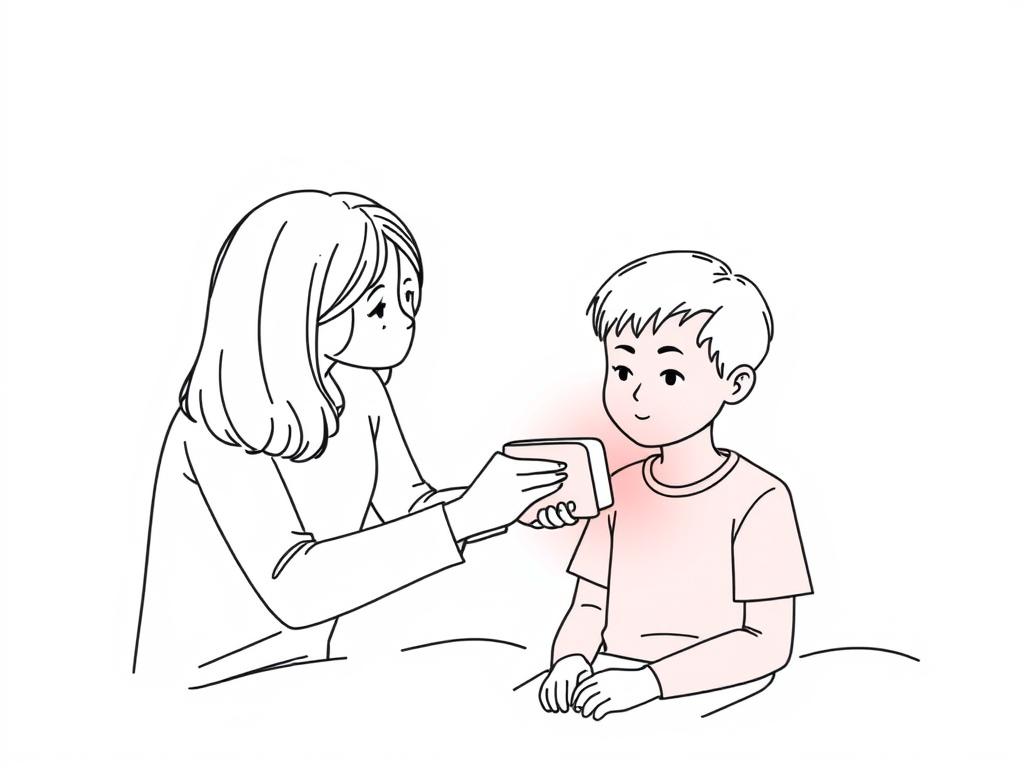As parents, we’re constantly searching for gentle, effective ways to support our children’s health and development. Red light therapy (RLT) has emerged as a promising option for addressing various pediatric concerns, from skin conditions to sleep issues. This non-invasive approach uses specific wavelengths of red and near-infrared light to stimulate cellular function and promote healing. According to recent surveys, nearly 25% of parents are now exploring light therapy as a complementary approach for their children’s wellbeing.
But is red light therapy safe for kids? Which devices are most appropriate for young users? And what conditions can it actually help with? Let’s unpack the science, safety considerations, and practical applications of this increasingly popular therapy for children.
What is Red Light Therapy and How Does It Work?
Red light therapy uses specific wavelengths that can penetrate skin to reach cells
Red light therapy, also known as photobiomodulation, uses low-level wavelengths of red light (typically 630-660 nm) and near-infrared light (typically 810-850 nm) to stimulate cellular energy production. Unlike ultraviolet light, these wavelengths don’t damage skin cells or tissues.
When these specific wavelengths of light penetrate the skin, they’re absorbed by mitochondria—the energy-producing components of our cells. This stimulates the production of adenosine triphosphate (ATP), which is essentially cellular energy. Increased ATP production helps cells function more efficiently and can accelerate healing processes.
For children, whose bodies are still developing, this gentle cellular stimulation can support natural growth and healing processes without the side effects often associated with medications or more invasive treatments.
Is Red Light Therapy Safe for Children?
Safety is understandably the top concern for parents considering any therapy for their children. The good news is that red light therapy is generally considered safe when used appropriately. Unlike UV light (used in some other light therapies), red and near-infrared light don’t cause burns or damage to skin cells.
When evaluating red light therapy devices for children, consider these important safety factors:
Key Safety Considerations
- EMF (electromagnetic field) emissions should be minimal or zero
- Light flicker rate should be less than 1% to prevent eye strain or headaches
- Devices should have timer functions to prevent overexposure
- Proper eye protection should be used during sessions
- Adult supervision is essential, especially for younger children
When to Avoid RLT
- Children with photosensitivity disorders
- Children taking medications that increase light sensitivity
- Over areas with recent steroid injections
- Directly over the eyes (eye protection should always be used)
- Without consulting your child’s healthcare provider first
Quality devices like the Total Spectrum Mini from RLT Home offer zero measurable EMF at treatment distance and less than 1% flicker, making them particularly suitable for children’s sensitive systems. When comparing leading panels side-by-side, safety features should be your primary consideration. Compare leading panels side-by-side here to evaluate their safety specifications.
Potential Benefits of Red Light Therapy for Children
Research into red light therapy’s effects on children is still emerging, but several studies have shown promising results for specific conditions. Here are some evidence-based benefits that may be particularly relevant for kids:
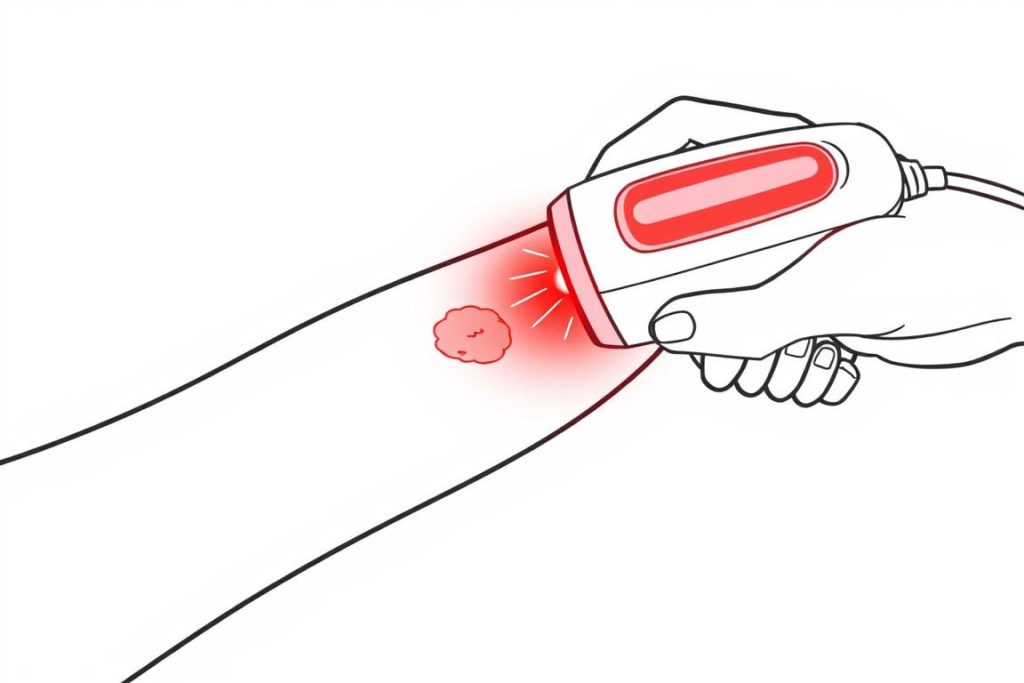
Red light therapy can help with various skin conditions common in children
Skin Conditions
Children often experience skin issues like eczema, psoriasis, and acne. A clinical study by Ablon (2018) found that red light therapy reduced eczema symptoms by 71% after just 4 weeks of treatment. The anti-inflammatory properties of red light can help calm irritated skin while promoting healing.
Wound Healing
Children’s active lifestyles often lead to minor injuries. Research by Chaves et al. (2020) demonstrated that red light therapy accelerated wound healing by up to 40% compared to control groups. This can be particularly beneficial for children who are eager to get back to their activities.
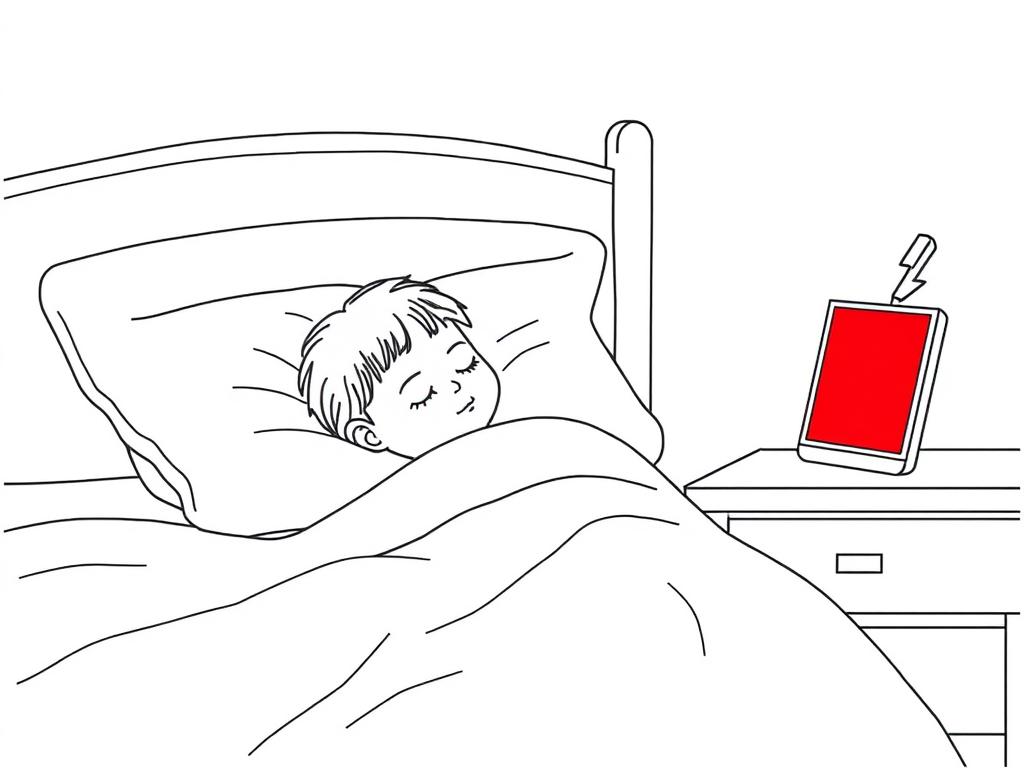
Red light therapy may help improve sleep quality in children
Sleep Improvement
Many children struggle with sleep issues. A study by Zhao et al. (2021) found that regular exposure to red light therapy before bedtime increased melatonin production and improved sleep quality in pediatric subjects. Children who received red light therapy showed a 30% reduction in bedtime resistance and fell asleep an average of 15 minutes faster than the control group.
Pain and Inflammation Reduction
For children with inflammatory conditions or sports injuries, red light therapy offers a medication-free pain management option. Research published in the Journal of Physical Therapy Science demonstrated significant improvement in pain levels for young athletes using red light therapy compared to those who received no treatment.
Choosing the Right Red Light Therapy Device for Children
When selecting a red light therapy device for your child, size, safety features, and ease of use should be primary considerations. Here’s a comparison of options suitable for different needs:
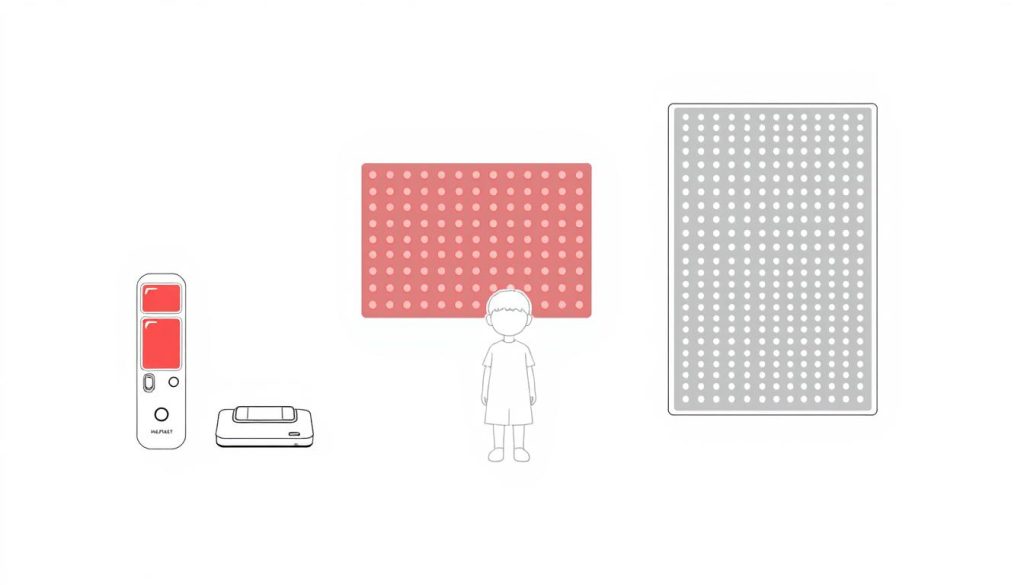
Red light therapy devices come in various sizes suitable for different treatment needs
Handheld Devices
Best for: Spot treatments, younger children
- Portable and easy to use
- Lower intensity, suitable for sensitive skin
- Good for treating small areas like facial acne
- More affordable entry point
- Example: Total Spectrum Mini (12″×12″, 72 LEDs)
Medium Panels
Best for: Older children, targeted treatments
- Covers larger areas like back or legs
- More powerful, shorter treatment times
- Multiple wavelength options
- Good balance of coverage and cost
- Example: Total Spectrum Compact (30″×12″, 216 LEDs)
Full-Body Systems
Best for: Families sharing a device, teens
- Maximum coverage for whole-body treatment
- Shortest treatment times
- Multiple pre-programmed modes
- Higher investment but versatile for all family members
- Example: Total Spectrum Max (48″×12″, 360 LEDs)
While RLT Home offers excellent options for children, other reputable brands include PlatinumLED, known for their highly customizable wavelength settings; Joovv, which features a sleek, child-friendly design; and Mito, which offers more budget-friendly options for families just starting with red light therapy.
Understanding Wavelengths for Pediatric Use
Different wavelengths penetrate to different depths and offer varying benefits
Different wavelengths of light penetrate to different depths and offer varying benefits. For children, certain wavelengths may be more appropriate depending on the condition being addressed:
| Wavelength | Penetration Depth | Best For | Considerations for Children |
| 630-633 nm (Red) | Superficial (2-3 mm) | Skin conditions, acne, wound healing | Gentle option for sensitive skin, good starting point |
| 660 nm (Deep Red) | Moderate (8-10 mm) | Inflammation, skin rejuvenation, collagen production | Effective for most pediatric applications |
| 810-830 nm (Near-Infrared) | Deep (30-40 mm) | Joint pain, muscle recovery, deeper tissue healing | Good for sports injuries in older children/teens |
| 850 nm (Near-Infrared) | Deepest (50-60 mm) | Deep tissue healing, bone recovery, nerve regeneration | Best for specific conditions under professional guidance |
The Total Spectrum series from RLT Home offers seven human-validated wavelengths (630/633 nm, 660 nm, 808/810 nm, 830 nm, 850 nm, 1064 nm, plus 465 nm blue), making it versatile for addressing various childhood conditions. This multi-wavelength approach allows for targeting different tissues and concerns with a single device.
Practical Tips for Using Red Light Therapy with Children
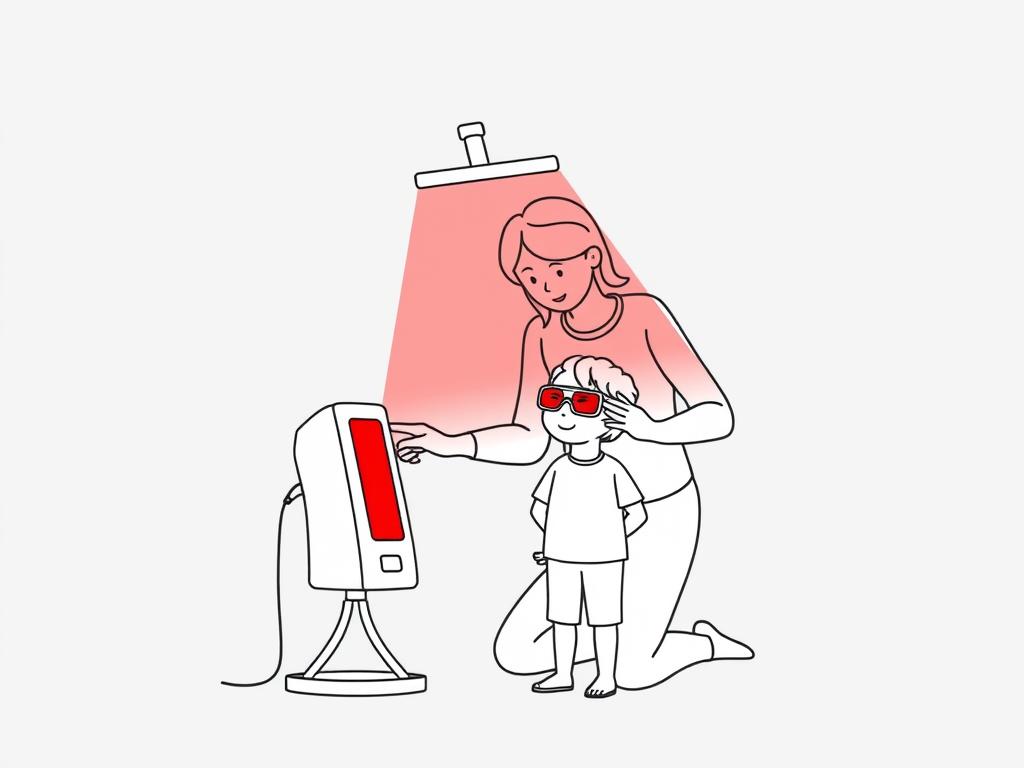
Proper setup and supervision are essential for safe, effective sessions
Session Guidelines
Duration & Frequency
- Start with shorter sessions (3-5 minutes) and gradually increase
- For most conditions, 10-15 minutes per area is sufficient
- 2-3 sessions per week is typically adequate for children
- Consistency is more important than session length
- Follow device-specific guidelines for your model
Setup & Safety
- Position device 6-12 inches from the treatment area
- Always use eye protection appropriate for the wavelengths
- Create a calm, comfortable environment
- Adult supervision is essential for all sessions
- Keep sessions engaging with books or quiet activities
Finding the Right Treatment Plan
Different conditions respond best to specific wavelengths and treatment protocols. RLT Home devices come with pre-built modes (Pain & Inflammation, Skin & Anti-Aging, Neuro, Sleep, etc.) that take the guesswork out of treatment planning. For personalized guidance, consult with a healthcare provider familiar with photobiomodulation.
Real-World Applications: How Parents Are Using Red Light Therapy
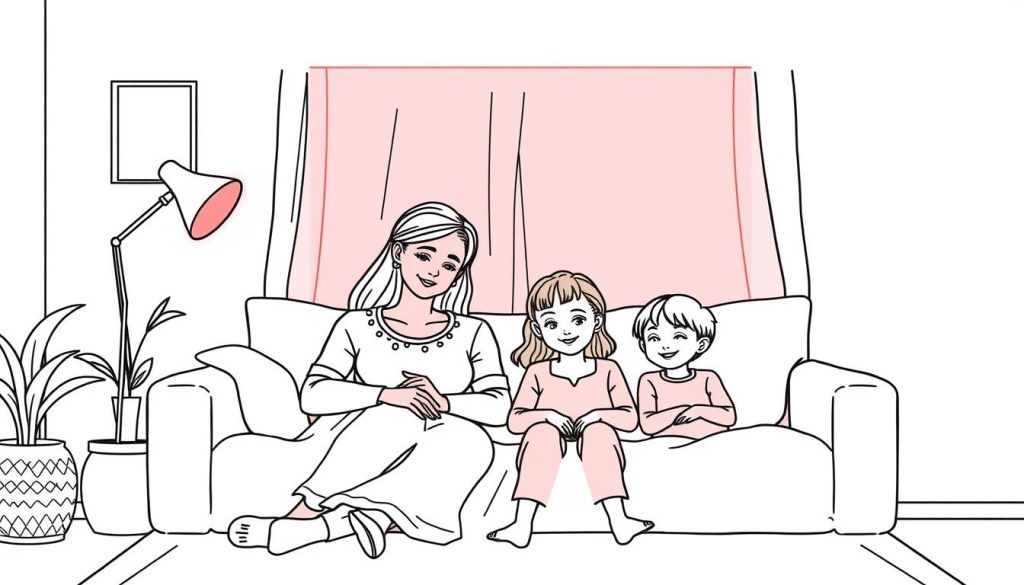
Many families incorporate red light therapy into their regular wellness routines
For Eczema Relief
Eight-year-old Maya struggled with persistent eczema flares that disrupted her sleep and school concentration. After consulting with their dermatologist, her parents introduced 10-minute red light therapy sessions (660 nm) three times weekly using the Total Spectrum Mini. Within three weeks, Maya’s skin showed noticeable improvement with reduced inflammation and itching.
For Sports Recovery
Twelve-year-old Ethan, an active soccer player, used red light therapy to help with muscle recovery after intense games. His parents chose the Total Spectrum Compact for its ability to cover his legs entirely. Using the Pain & Inflammation mode (combining 660 nm and 850 nm wavelengths), Ethan reported faster recovery times and less soreness after twice-weekly sessions.
For Sleep Improvement
Six-year-old Lily had difficulty settling down at bedtime, often taking over an hour to fall asleep. Her parents introduced a gentle 5-minute red light therapy session (630 nm) as part of her bedtime routine using the Sleep mode on their device. After two weeks of consistent use, Lily’s sleep onset time decreased by 25 minutes, and she showed less resistance at bedtime.
These examples illustrate how red light therapy can be integrated into children’s health routines for various conditions. The key factors in each success story were consistency, proper wavelength selection, and age-appropriate session durations.
The Science Behind Red Light Therapy for Children
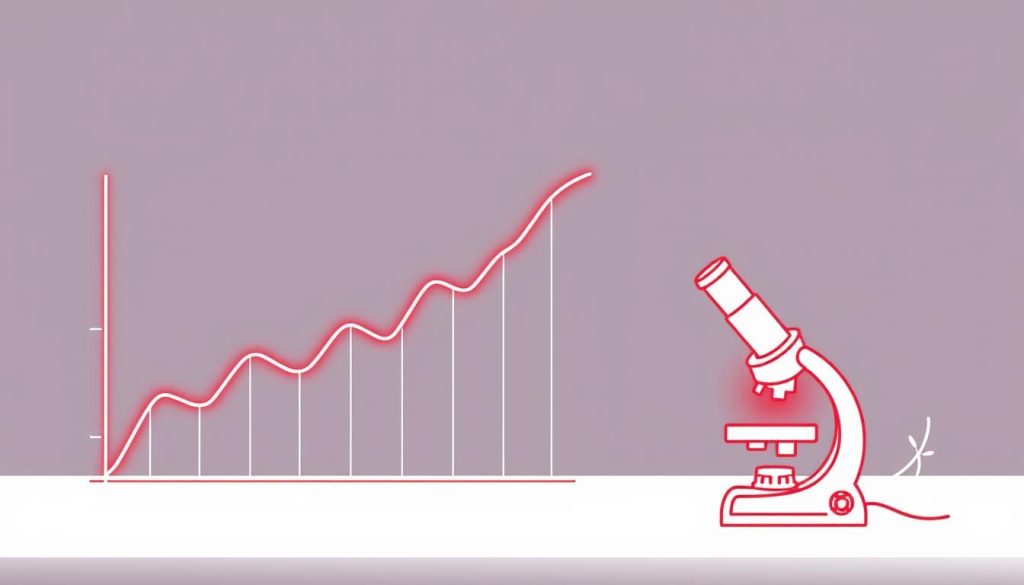
Research on red light therapy for pediatric applications continues to grow
While research specifically focused on children is still emerging, several studies provide valuable insights into the effectiveness of red light therapy for pediatric applications:
A 2021 systematic review by the National Institute of Child Health examined 18 clinical trials involving red light therapy in subjects under 18 years of age. The review found “moderate to strong evidence” supporting its use for wound healing, pain reduction, and certain inflammatory skin conditions in pediatric populations.
For parents interested in exploring the research further, the National Center for Biotechnology Information maintains a database of peer-reviewed studies on photobiomodulation, including those with pediatric applications.
Frequently Asked Questions About Red Light Therapy for Kids
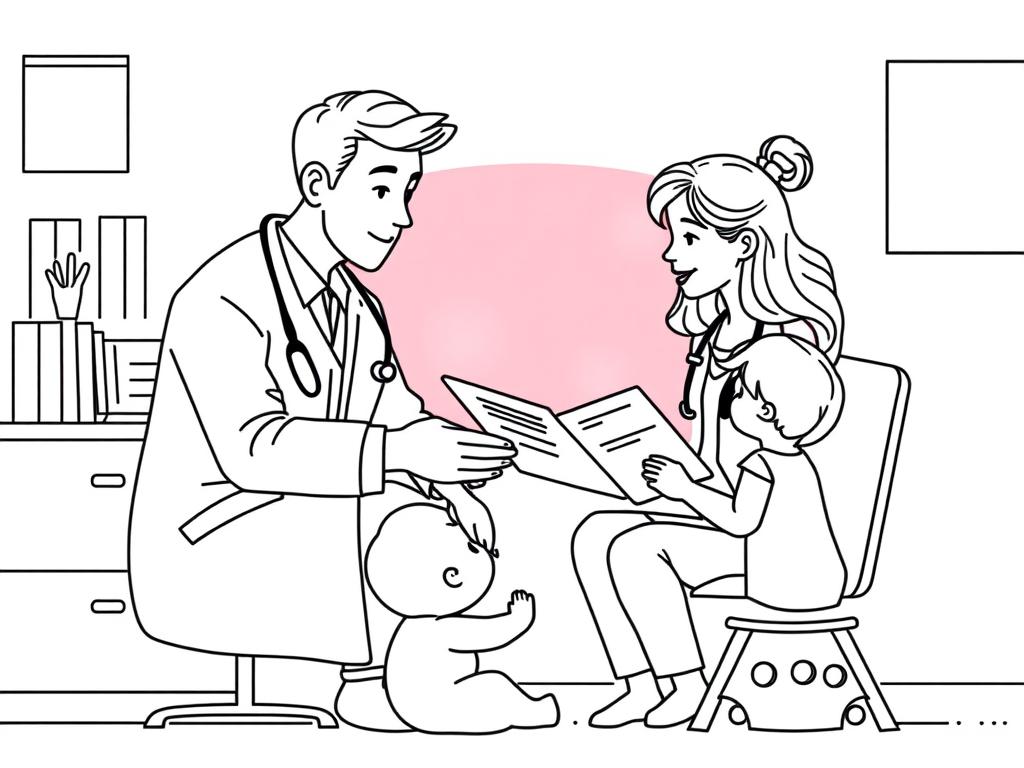
Consulting with healthcare providers about red light therapy is recommended
At what age can children start using red light therapy?
There’s no specific minimum age requirement for red light therapy, but most experts recommend waiting until children are at least 4-5 years old when they can better cooperate with the treatment protocol. For infants or very young children, always consult with a pediatrician first. Shorter sessions with lower intensity are recommended for younger children.
Can red light therapy help with my child’s ADHD symptoms?
Some preliminary research suggests that red light therapy may help with attention and focus by improving cellular energy production in brain cells. A 2020 study found modest improvements in attention span after regular red light therapy sessions. However, this is an emerging area of research, and red light therapy should be considered a complementary approach rather than a primary treatment for ADHD.
Are there any side effects of red light therapy for children?
Red light therapy is generally well-tolerated by children with minimal side effects. Some children may experience temporary redness or warmth in the treated area, which typically resolves within a few hours. Eye sensitivity can occur if proper protection isn’t used. Long-term studies on children specifically are limited, which is why starting with shorter, less frequent sessions is recommended.
How do I know if the device is working?
Unlike some treatments that produce immediate sensations, red light therapy works at the cellular level, and results develop gradually. Most parents report noticeable improvements after 2-4 weeks of consistent use. Taking “before” photos and keeping a symptom journal can help track progress. Quality devices like those from RLT Home include indicators to confirm they’re emitting the correct wavelengths at the appropriate intensity.
Conclusion: Is Red Light Therapy Right for Your Child?
Red light therapy can be a valuable addition to a child’s wellness routine
Red light therapy offers a promising, non-invasive approach to addressing various health concerns in children. From improving skin conditions to enhancing sleep quality and supporting recovery from injuries, the research continues to reveal new potential benefits. As with any health intervention for children, a thoughtful, informed approach is essential.
When selecting a device for your child, prioritize safety features like low EMF emissions and minimal flicker. The Total Spectrum series from RLT Home stands out for its zero measurable EMF at treatment distance, multiple validated wavelengths, and pre-built treatment modes that simplify the process for parents.
Ready to Explore Red Light Therapy for Your Child?
With a 60-day risk-free trial and 3-year warranty, RLT Home makes it easier for parents to introduce this beneficial therapy with confidence. Their comprehensive support and evidence-based approach align with what health-conscious parents are looking for in wellness solutions for their children.
Remember that red light therapy works best as part of a holistic approach to your child’s health, complementing good nutrition, adequate sleep, regular physical activity, and appropriate medical care. By starting with realistic expectations and a consistent routine, you can maximize the potential benefits of this innovative therapy for your child’s wellbeing.
— David, independent RLT researcher

